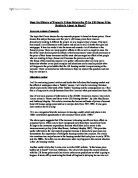The period from the early 1970’s to the early 1980’s saw a massive rise in commodity prices. Between 1972 and 1982 they rose by around 300% compared to output prices. Other factors associated with the rise in unemployment at this time include: the rise in the taxes on labour, the introduction of employment protection legislation and a sharp rise in the level of real interest rates at the start of the 1980’s. There is a strong opinion that increases in payroll taxes do not affect the labour market as they basically have the same effect as VAT for example. However, workers on minimum wage cannot have their wages adjusted downwards with a switch from VAT to payroll tax. This increased tax burden is then picked up by the employers who in turn reduce employment of these workers. Employment protection legislation and real interest rates play minor roles. Employment protection legislation hardly affects the equilibrium unemployment rate but does reduce adjustment speeds. Real interest rates, even very large changes, make little difference to the unemployment equilibrium.
Many of the original causes of the rise in the equilibrium rate have turned around but still the expected fall to previous levels of unemployment has not happened. In real terms, commodity prices have reduced back to their late 1960’s level. The benefit scheme is not as slack as in the past and has been tightened up. Trade unions have eased the pressure on wage demands. These factors should be pushing the equilibrium level back to the levels of the 1960s yet it is not happening. Certain reasons for this may include the fact that housing benefits are withdrawn very quickly upon entry into employment, creating a great disincentive to work. Because the long term unemployed find it very difficult to get back into work, no major improvement in unemployment rates was evident.
Also, since the mid 1980’s, the decline of North Sea oil production has added pressure to the trade balance, this tending to raise the unemployment equilibrium. Most important factor of recent times is that of the shift in demand in favour of skilled workers over the unskilled. This change has been brought on by technical changes {e.g. the use of computers and higher technology requires skilled workers} and from competition from newly industrialised countries. Even with high unemployment levels, the shortage of skilled labour creates inflationary pressure in the labour market. This has helped high unemployment equilibrium carry on into the 1990’s in the UK.
Now lets take a look at European unemployment affairs over the same time period. Most European countries with the possible exception of Norway experienced the effects of recession during the 1970’s. A main reflection of this was in rising unemployment, particularly in countries such as Germany, France and Denmark. At the same time there was an ever rising rate of inflation which hit all European countries. Most countries were suffering after demand was allowed to keep on building and also, from the external shock of sharp rises in oil prices. The first oil shock was in 1973 at a time when the dollar was not very strong and the USA cancelled the Gold Convertibility Standard. At this time world finances were in a bad way and major oil producing countries managed to impose huge rises in crude oil prices on the rest of the world. This was repeated in 1979 as a result of Iranian political crisis. It was not the increase in energy costs that were directly the cause of problems but the shock waves hitting world financial systems, as they had to manage huge new flows of funds and debts.
High unemployment in the 1980’s was also the result of the upsurge of wage demands in western countries in the 1960’s and 1970’s; this causing a growth of wage induced inflationary pressures. Inflationary pressures had been a constant factor in the rise in unemployment since the post war period where unions were learning to anticipate inflation and build a provision for it in their wage claims. Wage pressures brought low profitability and productivity in countries, another cause also being the slowdown in international trade. This build up led to the mass unemployment of the 1980’s and its aftermath had begun.
The period of time between 1973 to 1987 is an interesting period of time to look at as it marks the beginning to end of the 1980’s crisis in the UK and Europe. During this period of time, unemployment hit certain countries a lot harder than others and from this we can make comparisons and provide explanations for the differences in unemployment figures between the UK and Europe.
Here I now look at wage rigidity and the consistency of the economy as my points of discussion to explain the differences between UK and European unemployment. Statistics from the OECD {Organisation for economic co-operation and development}, below, show the degree to which national changes in the rate of unemployment over the period 1973 to 1987 were related to national wage rigidity. The greater the figure the larger the increase in unemployment.
Countries with large increases Countries with small increases
Belgium 8.9 Austria 2.6
Denmark 7.0 Finland 2.6
France 8.0 Sweden -0.1
Italy 5.1 Switzerland 0.6
Netherlands 8.3
United Kingdom 9.2
With these statistics it was seen that countries with a high rise in unemployment also had a high real wage rigidity {best example being the UK}. Because the UK did not have wage flexibility during this period it could not protect its economy from shocks as well as other countries and hence, the UK had the highest unemployment figure for the period.
Wage rigidity or its converse, wage flexibility, can give a good understanding and explanation for differences in unemployment levels. Wage rigidity is the immediate reason for an economy’s inability to survive economic shocks. Wage rigidity is the tendency of salaries or wages to remain fixed or rise in times of increasing unemployment. By being flexible and lowering wages in times like these will help rejuvenate demand and help avoid large rises in unemployment.
A problem with the UK economy compared to other European economies is its inconsistency. Certain European economies {Scandinavia and Austria} take a corporatist approach while others are characterised as free market economies {Switzerland and Sweden}. Characteristics of corporatist include strong central negotiating and planning mechanisms helping achieve co-operation between unions and businesses on policies such as wage fixing. Free market economies are wholly decentralised with little state intervention.
With a consistent framework and approach to political and economic understandings, actions taken to counter economic shocks can be done in a consistent way. The UK’s institution consists of trade unions with large memberships and sometimes considerable local bargaining power. To go with this we have weak central institutions for negotiating, coordinating and planning. There is no easy way to make decisions in responses to economic pressure or shocks with this decentralised nature of wage fixing in the UK. Economies that have a consistent institution will have the best chance of reaching their goal of full employment.







